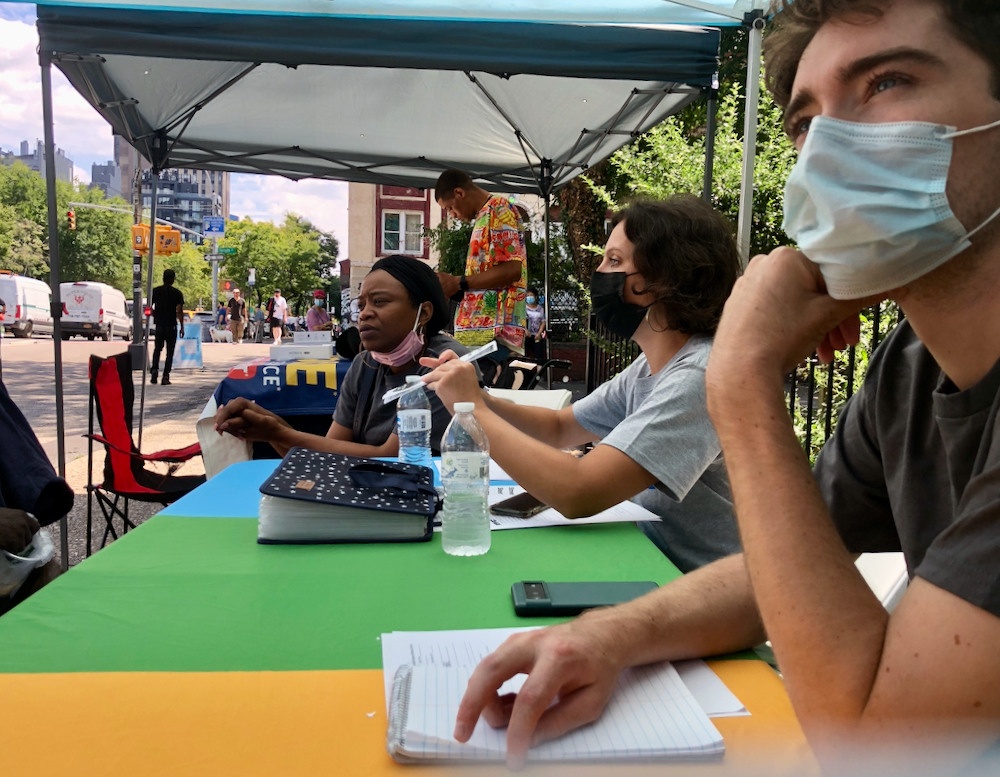
Eddie* had an apartment, but somehow he was still living on the street.
At a table in front of Sara D. Roosevelt Park, he told our homeless outreach team that everything had gone wrong when he let his sister and the sister’s abusive partner move in. Their cruelty quickly drove him out. A frail-looking man with thinning white hair, he was afraid to complain to management or take out a restraining order. Instead he was sleeping outdoors—and not for the first time.
Outreach worker Liam Simpson nodded and asked him questions in a friendly, casual tone, like they were two friends just catching up. “How would you feel about going into a Safe Haven?” he asked. “That’s transitional housing, not a shelter, and they generally offer a little more privacy and support. But the majority are shared—you’d be sharing a room.”
Eddie looked doubtful. “Can I be by myself?”
“I totally hear you,” said Liam. “But a single room is probably going to be a lot harder to get.”
On the street, a fast-moving line of people waited for soup and bread from a City Relief truck. City Relief is a religious nonprofit that offers food, clothing, hygiene kits and prayer to unhoused people at locations around town. They also help connect people to services such as housing and food stamps.
City Relief originally proposed this weekly pop-up to bring more intensive and collaborative services here. Local residents have been complaining the park feels unsafe due to substance use and people sleeping outside. Along with Goddard and City Relief, the visiting nurses were tabling that day, as well as a government-subsidized cellphone program.
Outreach isn’t usually done from behind a table. As the name implies, our outreach teams typically roam all corners of Manhattan, both by vehicle and on foot, approaching unhoused people wherever they find them. But Alyssa Wrinkle, director of our Downtown team, says switching up techniques can be good.
“Sometimes it’s easier to get buy-in if you’re offering something immediate. A hot, prepared meal is a way in,” she says. “And when people choose to come to our table, they’re coming into our space. It’s more empowering for them.”
Sitting next to Liam as he talked to Eddie, Wrinkle had an idea. “We might be able to get you a stabilization bed by yourself,” she said. “That’s a different kind of transitional housing for people who don’t need as much support.”
Eddie agreed to that, so Wrinkle put in the request. “Stay close by for a while,” she told Eddie. “If it comes through and we can’t find you, I don’t know how long they’ll hold it for us.”
More people began to stop by. At times, Simpson, Wrinkle and a third outreach worker, Tanisha Bradbury, were all talking to clients at once. There was a man out on parole who’d been directed to go to a homeless shelter, but wanted to get into transitional housing. Another said she’d been on the streets for 15 years. Most had no desire to share a room—a challenge Goddard’s homeless outreach workers wrote about in the Daily News recently. In addition to offering services, the three team members handed out masks, hand sanitizer, condoms, toothbrushes, and cold water.
When the two-hour popup was nearly over, Wrinkle’s phone rang: miraculously, a single room was available for Eddie in a new transitional housing residence.
“That’s great!” she exulted, hanging up. “I can’t believe we got him a single.” She scanned the crowd, but Eddie was gone. Without a cell phone or permanent address, finding him was going to be a challenge.
Sighing, Wrinkle headed out to walk the length and breadth of the park. There were lots of people sleeping on benches, but none of them looked like Eddie. “This is why I like to settle things while people are at the table,” she said. “So often this is how it goes: an opening and then a setback, an opening and a setback.”
After walking several blocks, she headed back. Then her phone rang again. Eddie had stopped by the table. Wrinkle hurried back to meet him.
Eddie had lots of questions about the room on offer—”Is it clean? Will I have my own bathroom? Will I have my own key?”—but he brightened when he learned the residence was just a couple of subway stops from his apartment. Now he seemed genuinely excited. But there was one last obstacle to overcome.
“I need to take this to someone over on Delancey,” he said, waving an unlit cigarette. “I promised my friend. That’s why I came out here in the first place.”
Nobody was keen on letting Eddie get away again. But Wrinkle agreed on the condition that he come straight back. She nixed the idea of sending someone with him, explaining later: “Once you start following people around to trade cigarettes, you’re doing too much.”
She sent Bradbury and Simpson back to the office, and another team member came to the park to accompany Eddie to the residence. They waited. The minutes ticked by. The shadows lengthened. An unhoused man who seemed to have commandeered a Citibike asked for a bottle of water. The team member spotted a client he had recently placed in housing, and went over to see how he was doing.
Just when it seemed their luck had run out again, Eddie came back.
Moments later, he was heading to his new room in an outreach SUV. All the other organizations had long since packed up their tables and left. Wrinkle began walking back to the office. It had been a good day at the park.
*The client’s name and identifying details have been changed to protect privacy